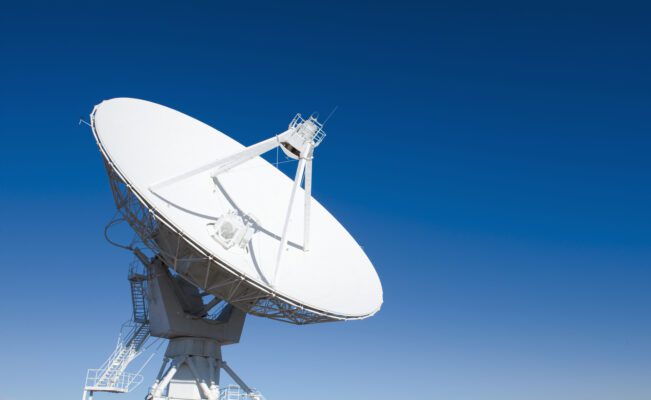Satellites orbit the Earth or other celestial bodies in fixed orbits, most of which have a scientific or commercial purpose.
What is a Satellite?
Satellites are artificial spacecraft , celestial bodies designed to be placed in space in a specific orbit. This is done for military, commercial or scientific purposes. These astronomical objects orbit the moon, a planet or a star.
The satellite basically consists of the payload, commercial or military, and the basic structure. In addition, there are required subsystems that serve the drive.
Tasks of satellites
Satellites are always put into space for specific purposes, such as research or the transmission of news. So-called broadcast satellites , for example, transmit television programs or radio stations directly to the receiver, eliminating the need for terrestrial networks.
Positioning data is determined worldwide using navigation satellites, such as the GPS system. This technology is then used in vehicles for navigation or in GPS trackers for location determination. Such GPS data can also be used to evaluate and optimize processes and movements. Military satellites are used for surveillance and defense, either as spy satellites for spying or for destroying enemy spacecraft.
How are satellites powered?
In order to supply the satellite with sufficient energy, solar cells are usually attached to the missile . These are supported by accumulators; these elements store energy and are rechargeable. Before launch, satellites are equipped with energy; this is usually needed for launch and corrective maneuvers. Thanks to external energy sources such as solar radiation or magnetic fields, the missile always has new energy available.
Satellites orbit the earth
Hundreds of satellites are in orbit around the Earth and can stay in the same orbit for long periods of time because Earth’s gravity is balanced by centrifugal force. Outside the Earth’s atmosphere there is no air resistance that could slow down satellites, this enables a constant orbit with a constant orbital speed .
Satellites in particular that are required for communication or communication satellites are in a geostationary orbit, which is why they are called geostationary. This orbit is at an altitude of about 35,800 km above the Earth’s surface. Such a satellite is placed in geo-orbit and orbits the earth within 23 hours and 56 minutes, meaning it moves in orbit around the earth at the same time.
Satellite orbits change their speed; the distance to the mass point of the missile and its mass is crucial for a stable orbit.
Benefits of satellites
Satellites are launched into space to perform specific tasks; depending on the purpose, the correct earth orbit and altitude must be selected.
orbits
Geostationary satellites do not move in relation to the Earth, they always remain in the same place because they move with the Earth. This circular orbit is always above the equator and the inclination of the orbit is 0°. If the orbits were inclined to a greater extent, the satellite would not remain in its position, so placement is only possible above the equator . In addition to the geostationary trajectory, satellites can be placed at different altitudes. Due to the orbital time and positioning, it is always visible to the observer on the ground on this orbit .
Different orbits

The parking orbit describes the orbit closest to Earth. It is at an altitude of between 150 and 200 km. When a launch vehicle is launched to place a satellite, this area is targeted first. Due to the instability, this is quickly abandoned after the route has been successfully calculated; it is considered an intermediate station between the earth and the targeted orbital plane .
Low Earth Orbit , also called LEO: This satellite orbit is used for manned space flights, weather satellites or amateur radio satellites . This near-Earth circular orbit is at an altitude of between 200 and 2,000 km. Due to the short distance, LEO orbits can be easily reached and the energy required is lower. The solar-synchronous orbit, SSO for short, describes the orbit around a planet; the orbital plane experiences the same change in rotation as the celestial body orbiting around the sun .
In the medium earth orbit, the so-called Medium Earth Orbit , or MEO for short, satellites move at an altitude of 2,000 to 36,000 km. This orbit is primarily used for global communications satellites ; satellites from the GPS, GLONASS and Galileo systems are also placed there. The polar orbit describes orbits that run over polar regions, with the orbit inclination being around 90°. The Highly elliptical Orbit has a highly elliptical orbit. These can be at an altitude of 200 to 15,000 km or between 50,000 and 400,000 km. Such orbits are particularly suitable for highly elliptical orbit satellites or Molnija satellites for science, military purposes or telecommunications. Among other things, it serves as a transfer orbit for the international space station . In space travel, it is used primarily for spacecraft that aim for the moon. Graveyard orbit refers to orbits into which satellites whose service life has been exceeded are directed.
Benefits of Earth’s orbit
The Earth orbit describes a trajectory on which a satellite orbits the Earth. The speed and orbital period always depend on the purpose of the satellite. It is determined in advance for which project the satellite is needed so that the central body can be placed at the appropriate altitude above the earth.
Launch of satellites

In order to bring the desired satellite into space , an appropriate launch vehicle or space shuttle is necessary. There are around 27 locations worldwide from which satellites are launched into space using such a rocket; they are usually close to the equator .
There are currently around 2,000 satellites in various orbits, a third of which are used for earth observation and climate research. Another third is dedicated to science, communication and navigation on Earth. More than half are in low orbit or even below. Only a small number travel at an altitude of over 36,000 km.
Lifespan of satellites
From an altitude of around 800 km, satellites can remain in space for more than 10 years. Satellites placed higher even longer. If these are no longer needed and are transported into the graveyard satellite orbit, they contribute to space debris, where they then remain. Satellite crashes can rarely be predicted due to the many factors and movement , but a malfunctioning missile is not an isolated incident. A satellite that is out of service and falls to Earth rarely reaches the ground. The individual parts usually burn up when they enter the Earth’s atmosphere from space, but in very rare cases the debris of the missile actually reaches our planet Earth.


